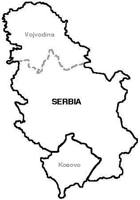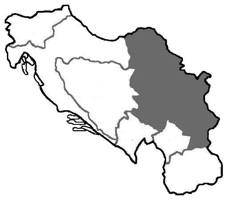
|
The Society of Folk Dance Historians (SFDH) Serbia
Home |
About |
Encyclopedia | CLICK AN IMAGE TO ENLARGE |

|
BACKGROUND
Serbia is a country situated at the crossroads of Central and Southeast Europe. It is located on the Balkan Peninsula, southwestern Europe, in the southern Pannonian Plain. Serbia borders Hungary to the north; Romania and Bulgaria to the east; Macedonia to the south; Croatia to the south, Kosovo to the southwest, and Montenegro and Bosnia-Hercegovina to the west.
During the breakup of Yugoslavia, the country declared independence in April, 1992 as Serbia formed a union with Montenegro, which was peacefully dissolved in 2006. In 2008, the parliament of the province of Kosovo unilaterally declared independence, with mixed responses from the international community.
The assassination of Archduke Franz Ferdinand of Austria on June 28, 1914 in Sarajevo by Gavrilo Princip, a member of the Young Bosnia organization, led to Austria-Hungary declaring war on Serbia. In defense of Serbia, and to maintain her status as a Great Power, Russia mobilized its troops, which resulted in Austria-Hungary's ally Germany declaring war on Russia.
In 1941, in spite of Yugoslav attempts to remain neutral in the war, the Axis powers invaded Yugoslavia. The territory of modern Serbia was divided between Hungary, Bulgaria, Croatia, and Italy (greater Albania and Montenegro), while the remaining part of Serbia was placed under German military administration
Nationalism across Yugoslavia eventually resulted in its breakup, with Slovenia, Croatia, Bosnia-Hercegovina, Montenegeo, Kosovo, and Macedonia declaring independence.
Most of the inhabitants of Eastern Serbia, along the Morava and the Timok rivers are of Vlach extraction. Many still speak Vlach at home. Zaječar, the largest city in the Vlach region of Serbia, and Negotin are East Serbian towns with strong concentration of Vlachs. The same applies to Vidin and Kula on the Bulgarianside of the border.
National Dances: Kolo
Location: Balkans
Regions: Šumadija, the great heartland south of Beograd.
Language: Serbian
Religions: Predominantly Serbian Orthodox Christian, Muslim
DOCUMENTS
- About Biserka-Bojerka, an article.
- About Ersko Kolo, an article.
- About Orijent, an article.
- Aj da Idem Jano, a song.
- Ajde Jano, a dance.
- Balkans, a region.
- Beware of Gift Giving Customs in Foreign Lands, a list.
- Biserka-Bojerka, a dance.
- Bora Gajicki, an article.
- Čačak Kolo, a dance.
- Čarlama, a dance.
- Ciga and Ivon Despotović, an article.
- Devojačko Kolo, a dance.
- Draganovo Kolo, a dance.
- Đelem, Đelem, a song.
- Fatiše Kolo, a dance.
- Gori More, a dance.
- Inner Joy of Yugoslav Dancing, an article.
- Ljubica and Danica Janković, an article.
- Jeftanovićevo Kolo, a dance.
- Jove Malaj Mome, a dance.
- Kolo, Some Background, an article.
- Leilam, a dance.
- Makazice, a dance.
- National Geographic Magazine Folklore Index 1914-1997, a list.
- Niška Banja, a dance.
- Old-Tyme Kolos, a book.
- Opsa, a dance.
- Polomka, Metovničanka, i Kostenka, dances.
- Pop Marinko, a dance.
- Prekid Kolo, a dance.
- Ramo-Ramo, a dance.
- Sa, Sa, a dance.
- Šetnja, a dance.
- Sing and Dance the Kolo, a book.
- Srpske Narodne Melodije, a book.
- Survival or Extinction, an article.
- Tamburitza in History, an article.
- U Šest Koraka, a dance.
- Vlachia, a region.
- Vladimir Đorđević, an article.
- Yugslavia, a former country.
- Zikino Kolo, a dance.
This page © 2018 by Ron Houston.
Please do not copy any part of this page without including this copyright notice.
Please do not copy small portions out of context.
Please do not copy large portions without permission from Ron Houston.
